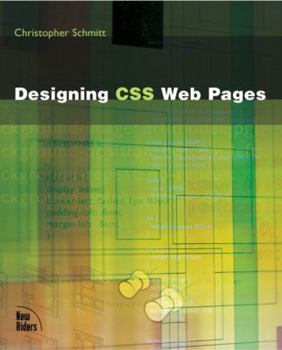Designing CSS Web Pages
Customer Reviews
Rated 5 starsa lot more than CSS
Christopher Schmitt has taken it upon himself to write a book that not only covers CSS, but the idea of designing websites with sanity in mind. Throughout the book, Schmitt distinguishes between good and bad things to do while you're designing a website. He talks a lot about what clients expect and that kind of things, something teachers need to go over more. He also provides coding for both CSS and Javascript, along with...
0Report
Rated 5 starsThe ideal choice for visual designers
I'm a graphic designer and have gathered some solid background in web design through the years.The moment I saw Christopher's tutorial "Web Page Reconstruction with CSS" [the website] on Digital Web Magazine mentioning the upcoming book, I immediately knew that this was the book for me.It turned out to be an eye-opening experience starting with the structured content and moving towards the "styled" end result purely with the...
0Report
Rated 5 starsA Great Place to Start
As a person with 8 years of web design experience, I know all too well that things are constantly changing. The vast majority of those years were spent creating table-based layouts. I needed something to jump start me and help me make the switch from table-based to CSS layouts. This book served as the perfect tool.In reading other reviews, where people complained about errors, I didn't run into this problem. I guess that's...
0Report
Rated 5 starsThis is a good book, but not for everyone.
In terms of quality, I'd rate this book as high as anything from Glasshaus, most prominently "Cascading Style Sheets: Separating Content from Presentation". This book covers a lot of the same ground as the Glasshaus title but I found it particularly useful due to its slightly more graphic design bent. The code samples in the book are not merely basic utility layouts (2 columns, 3 columns, vertical centering etc), but more...
0Report
Rated 5 starsDHTML`ers Bible.
Firstly, I loved this book. Very well written!As a Web Developer who specialises in writing DHTML based apps, I needed a resource that could provide me with industry raw tips to help making my CSS development that much more solid.I found the use of interviews with some of the pioneers in the web development industry to be well worth the purchase, as its great to see what the people who invent / author allot of the techniques...
0Report













